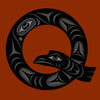Carving of Shanyaak’utlaax̱ (Salmon Boy), c. 1980 by Lelooska (1933 - 1996)
Regular price
$0.00
Sale
Carving of Shanyaak’utlaax̱ (Salmon Boy), c. 1980
Lelooska (1933-1996), Cherokee & Adopted Kwakwaka'wakw
red cedar, horse hair, pigment
25” diameter x 9” wide x 6" deep
This is the story of Shanyaak’utlaax̱ (Salmon Boy). His name was Aak'wtaatseen. He was snaring sea gulls. When he came home he was hungry. His mother gave him moldy salmon collar. Hey flung it away exclaiming "why do you always give me the moldy pieces of salmon!" Because of his words and actions, he offended the Salmon People.
In the distance he heard someone yell "A seagull has stepped into the eye of your snare!" The boy ran toward the water and his snare, but he was pulled into the water and disappeared. It was the Salmon People that did this to him!
Aak'wtaatseen was taken to the Salmon People's village. The leader of the Salmon People made him his son. The leader taught him about the Salmon People. He learned to treat the Salmon People with respect so they would return to the streams of their birth.
Now it was time to return to their streams. The Salmon People eventually ended up at the river of Salmon Boy's uncle. The salmon people told Aak'wtaatseen to stand and show himself, but when he did, his uncle and his mother did not see a boy, they saw a beautiful fish!
Aak'wtaatseen's father speared this beautiful fish for his wife, Aak'wtaatseen's mother. She went to clean the salmon but then recognized her son's copper necklace that he was wearing before he left them. They wrapped a blanket around the salmon, and in the morning he became a young man. He was human again.
From that day on, Aak'wtaatseen instructed the people how to care for the salmon. "We must treat them with respect or they won't return, and we must use all of them, and put the leavings in the water." In this way, the salmon will benefit us for many generations to come.
Master carver and storyteller Lelooska was born Don Smith in Sonora, California in 1933. He was called Yana the Bear at birth, but it was the name Lelooska, meaning "To Cut Against Wood With a Knife," that brought him fame. Lelooska and his family moved to Hubbard, Oregon in 1936, where they ran a gift shop, and where Lelooska began to carve under the tutelage of his grandfather He-Kill, Cherokee Nation from Oklahoma.
Though Lelooska was taught the traditional art and stories of the Cherokee, it was the carvings and myths of the Northwest Coast culture that inspired him to make carving a full time endeavor. He won acclaim for his totem poles, carved out of old-growth cedar. He is said to have carved 100 or more totem poles and thousands of masks, using only the D adze, the elbow adze and the hooked knives.
During Oregon's Centennial in 1959, Lelooska carved a 50-foot totem pole celebrating the state's role in Operation Deep Freeze, which established a scientific station at the geographic South Pole. The pole now towers over Washington Park Zoo in Portland. He carved a duplicate 30-foot Friendship pole, which dominates the entrance to the international airport at Christchurch, New Zealand.
In 1961, the family moved to Ariel. Volunteers helped build a traditional longhouse, a log museum, and later an art gallery. In 1968, Chief James Sewid, hereditary chief of the Kwakwaka’wakw Nation on Vancouver Island, held a potlatch to adopt Lelooska, his mother Shona-Hah, his sister Patty Fawn, and his brother Tsungani into the Sewid family.
Lelooska and his family offered traditional dance and storytelling performances, wearing the masks and robes of the Kwakwaka’wakw Nation of British Columbia. Lelooska, with his deep and commanding voice, brought to life the myths and legends of his ancestors.
The longhouse shows were among his proudest accomplishments, attracting 25,000 visitors a year. There were also workshops in American Indian culture offered by the nonprofit Lelooska Foundation, where students can earn college credits from Central Washington University and Lewis & Clark College.
Lelooska received an honorary doctorate from Lewis & Clark for his leadership in American Indian art and culture. He also was given the school's Aubrey Watzek Award for his contributions to American Indian culture. Lelooska has works in both Private and Public Collections including the National Museum of the American Indian, The Chicago Art Institute, The Portland Art Museum, and The Estate Collection of Arlene Schnitzer.
Lelooska passed away peacefully at home in Ariel, Washington in 1996.







